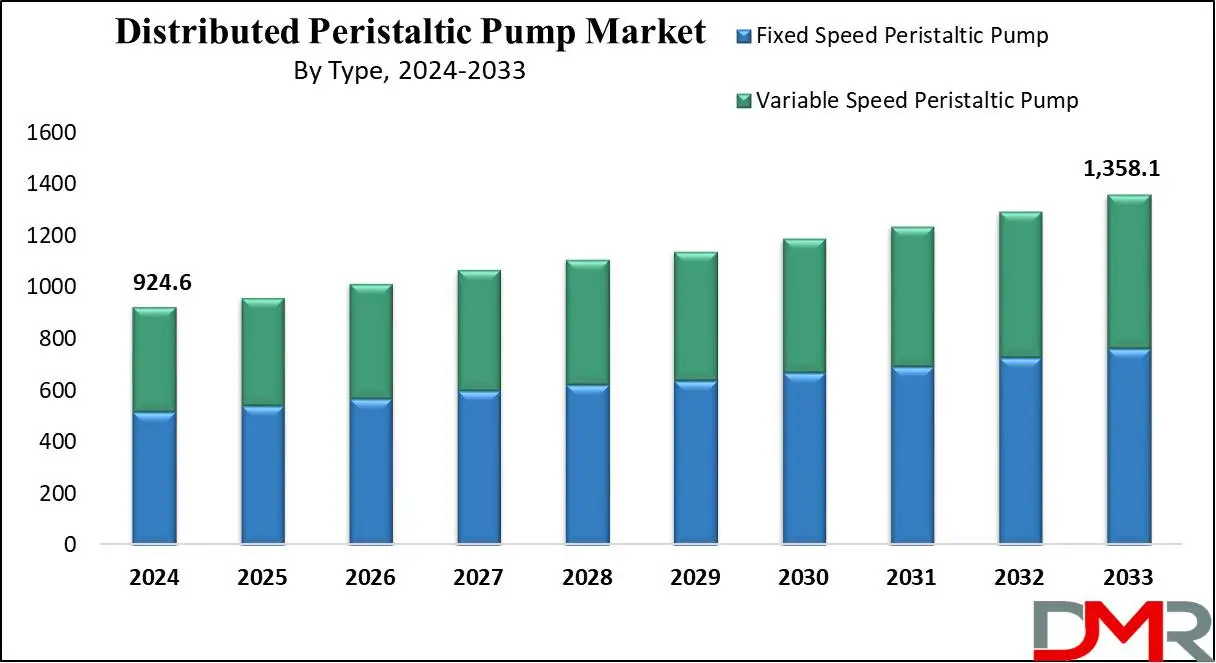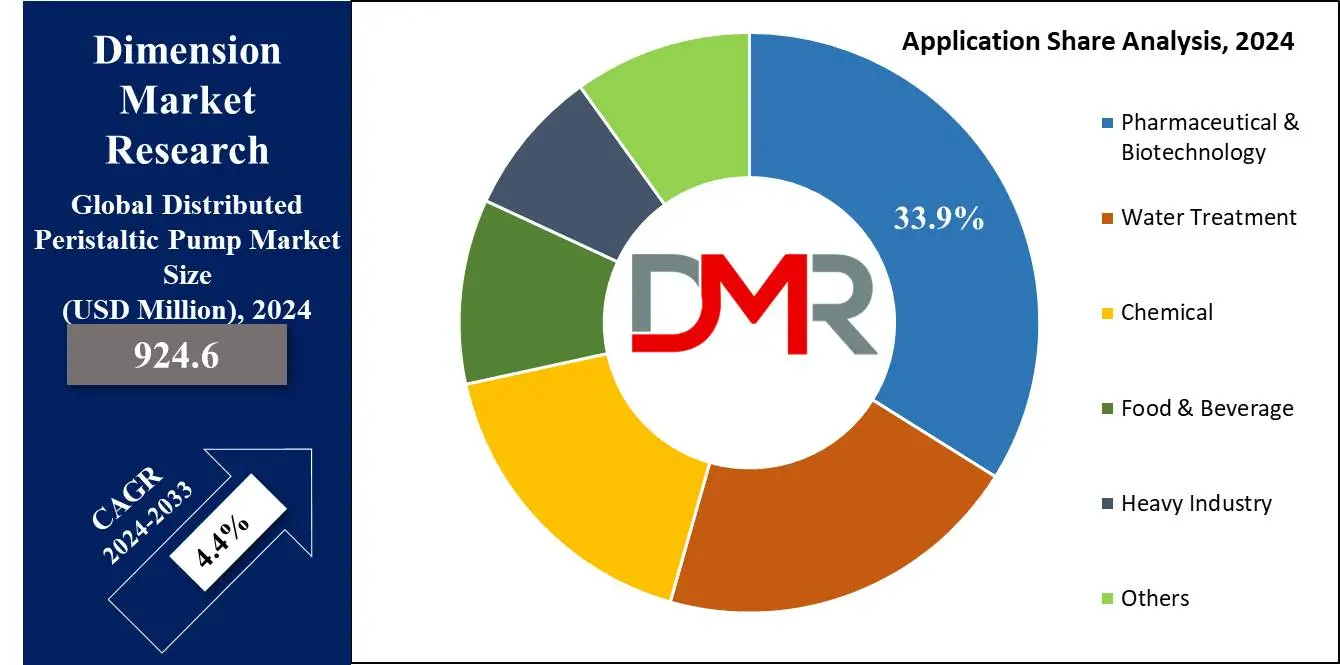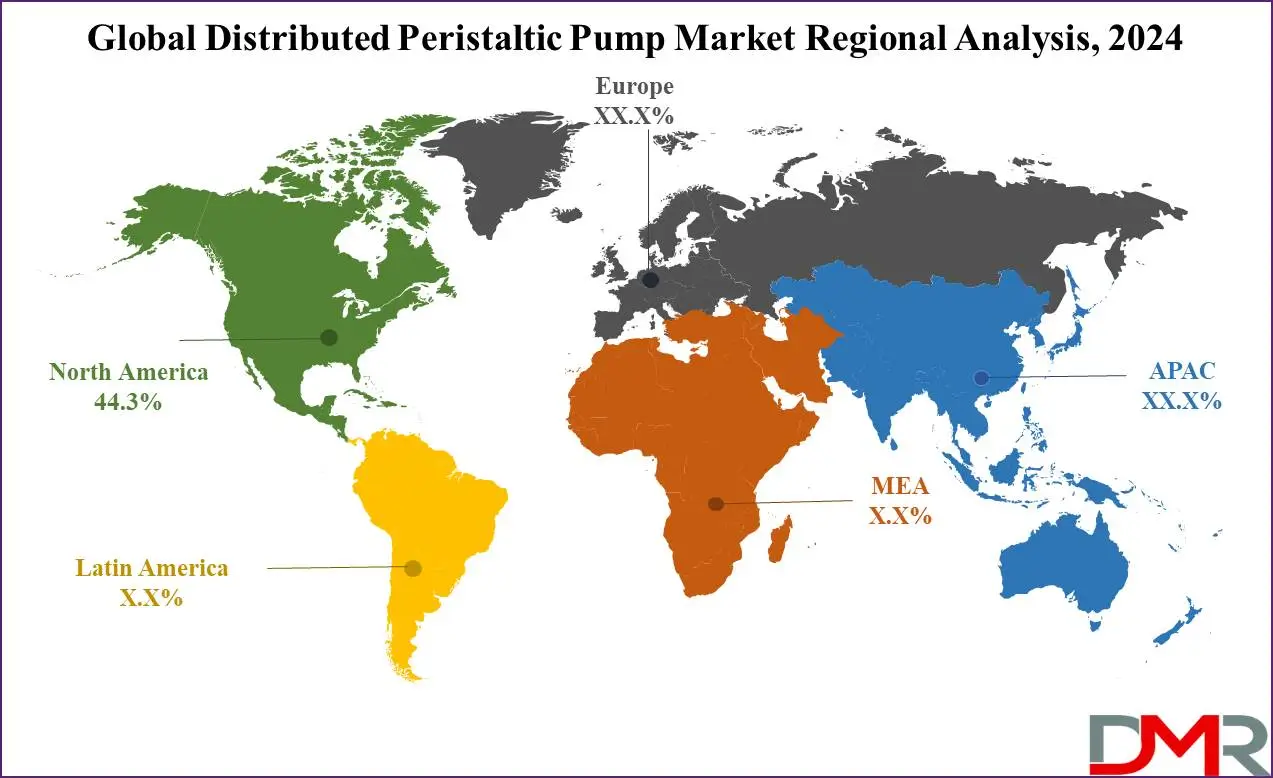The distributed peristaltic pump is a commonly used pump with the main function of transporting liquids to distinctive systems or equipment. A peristaltic pump is a special type of pump that uses elastic pipes with contraction and reciprocating movement characteristics to deliver liquid out like peristalsis. The distributive peristaltic pump is a new type of peristaltic pump, which adopts a different pump head developed from the traditional peristaltic pump, and distributes and disposes the pump head at the same time in the reciprocating movement, which can more accurately control the flow and discharge of liquid.

Key Takeaways
- Market Growth: The Distributed Peristaltic Pump Market size is expected to grow by 397.3 million, at a CAGR of 4.4% during the forecasted period of 2025 to 2033.
- By Type: The fixed speed peristaltic pump segment is expected to lead in 2024 with a major & is anticipated to dominate throughout the forecasted period.
- By Material: The stainless steel segment is expected to lead the Distributed Peristaltic Pump market in 2024.
- By Application: The Pharmaceutical & Biotechnology segment is expected to get the largest revenue share in 2024 in the Distributed Peristaltic Pump market.
- Regional Insight: North America is expected to hold a 44.3% share of revenue in the Global Distributed Peristaltic Pump Market in 2024.
- Use Cases: Some of the use cases of Distributed Peristaltic Pumps include medical devices, environmental monitoring, and more.
Use Cases
- Laboratory Automation: Used in automated liquid handling systems for accurate and controlled fluid transfer in laboratories, ensuring better experimental conditions.
- Medical Devices: Integrated into medical equipment like dialysis machines or drug delivery systems to maintain consistent & safe fluid movement within the human body.
- Food and Beverage Industry: Installed in industrial processes for metering and dispensing liquids in food and beverage production, maintaining hygiene and accuracy.
- Environmental Monitoring: Used in environmental monitoring stations for controlled distribution of chemicals or reagents in water treatment and analysis systems, ensuring reliable data collection.
Distributed Peristaltic Pump Market Dynamic
Driving Factor
Increasing Automation in HealthcareAs healthcare supports adopt more automated processes, there is an increasing demand for peristaltic pumps due to their precision, reliability, and ability to handle sensitive fluids. These pumps are critical in applications like drug delivery systems, dialysis machines, and laboratory automation, driving market growth.
Expansion in Biopharmaceutical Production
The biopharmaceutical industry's rapid expansion, mainly in areas like cell culture and bioprocessing, needed accurate fluid handling solutions. Peristaltic pumps are preferred for their ability to handle shear-sensitive materials and maintain sterile conditions, thus driving their adoption and market growth in
biopharmaceutical production applications.
Restraint
Cost Considerations
Peristaltic pumps can be relatively expensive in comparison to other types of pumps, which can be a deterrent for cost-sensitive applications or industries. The initial investment & ongoing maintenance costs may limit adoption, mainly in price-sensitive markets.
Limited Flow Rate and Pressure
Peristaltic pumps typically have lower flow rates and may struggle with higher pressures in comparison to other pump types like centrifugal pumps, which restricts their use in applications demanding high flow rates or pressures, like large-scale industrial processes or certain municipal water treatment applications.
Opportunities
Growth in Industrial IoT (Internet of Things)
The integration of peristaltic pumps with IoT technology allows for remote monitoring, data collection, and predictive maintenance, which improves operational efficiency, minimizes downtime, and enhances overall reliability, providing opportunities for growth in smart manufacturing and industrial automation sectors.
Expanding Applications in Emerging Economies
As healthcare infrastructure enhances and industrialization advances in emerging economies, there is an increasing demand for reliable fluid-handling solutions. Peristaltic pumps provide advantages in terms of accuracy, sterility, and versatility, making them suitable for many applications in pharmaceuticals, food & beverage, and water treatment industries in these regions, which provides a significant growth opportunity for market expansion in emerging economies.
Trends
Advancements in Pump Design and Materials
There is a trend towards the development of peristaltic pumps with better designs and materials, which includes innovations in tubing materials to improve durability, flexibility, and chemical resistance. In addition, developments in pump head designs and motor technology are enhancing efficiency and reliability, catering to different application requirements.
Focus on Sustainability and Environmental Impact
There is a high focus on sustainability within the pump industry, including peristaltic pumps. Manufacturers are developing more energy-efficient pumps that consume fewer resources, and are easier to recycle. In addition, there is a higher demand for pumps that minimize fluid waste and reduce environmental impact, aligning with global sustainability goals and regulatory requirements.
Distributed Peristaltic Pump Market Research Scope and Analysis
By Type
The distributed peristaltic pump market consists of two main types: fixed-speed peristaltic pumps and variable-speed peristaltic pumps. In 2024, fixed-speed distributed peristaltic pumps are expected to play a major role in driving the growth of the market due to their simplicity, reliability, and affordable. These pumps work at a consistent speed, making them ideal for applications where a constant flow rate is needed without the complexity of variable speed control. Industries like pharmaceuticals, food and beverage, and water treatment sectors value fixed-speed peristaltic pumps for their ability to handle delicate fluids & maintain sterility.
Further, their straightforward design minimizes the maintenance requirements and operational downtime, contributing to higher operational efficiency & lower total cost of ownership. As these industries constantly expand globally, mainly in emerging economies, the demand for reliable and efficient fluid handling solutions provided by fixed-speed distributed peristaltic pumps is expected to drive significant market growth in the coming years.
By Material
Based on material, the use of stainless steel materials in Distributed Peristaltic Pumps is anticipated to significantly contribute to market growth in coming years. Stainless steel provides several advantages that cater to the strict requirements of industries like pharmaceuticals, biotechnology, and food processing. Its inherent corrosion resistance ensures the durability and longevity of the pumps, even when exposed to harsh chemicals and sanitizing agents, which makes stainless steel peristaltic pumps ideal for applications where cleanliness & hygiene are most important, as they can withstand frequent cleaning & sterilization processes without degradation.
In addition, stainless steel's smooth surface finish provides contamination & ensures the integrity of sensitive fluids, maintaining product quality is critical in manufacturing processes. As industries continue to prioritize quality assurance & regulatory compliance, the reliability and performance provided by stainless steel distributed peristaltic pumps are expected to drive their adoption and contribute significantly to market expansion throughout the forecast period.
By Application
Pharmaceutical & biotechnology applications are predicted to play a vital role in driving the growth of the Distributed Peristaltic Pump market in 2024. These sectors require accurate and sterile fluid handling solutions for important processes like drug formulation, bioprocessing, and chromatography. Peristaltic pumps are preferred in these industries due to their ability to accurately meter & transfer sensitive fluids without contamination, due to their design that prevents contact between the fluids and pump components. Moreover, peristaltic pumps can handle several viscosities and shear-sensitive materials, which are common in
pharmaceutical and biotech applications.

As the need for biopharmaceuticals and personalized medicines continues to rise globally, the demand for reliable and efficient peristaltic pumps will grow, driving market growth. Also, manufacturers are expected to innovate further to meet the evolving requirements of these industries, enhancing the pumps' performance, reliability, and compliance with stringent regulatory standards.
By Distribution Channel
The online distribution channel is expected to significantly fuel the growth of the Distributed Peristaltic Pump market in 2024. As industries increasingly use digitalization and e-commerce platforms, online channels provide convenience, accessibility, and a broad reach to potential buyers globally. Distributors & manufacturers of peristaltic pumps can use online platforms to showcase their product portfolios, provide detailed specifications, and provide easy purchasing options, which allows businesses to reach a large audience of researchers, engineers, and procurement professionals across various sectors like healthcare, pharmaceuticals, food processing, and industrial automation.
In addition, online channels support efficient order processing, fast delivery, and customer support, enhancing overall customer satisfaction and loyalty. As the trend towards digital transformation continues, the online distribution of peristaltic pumps not only expands market visibility but also drives operational efficiencies and contributes to the overall growth of the market in coming years.
The Distributed Peristaltic Pump Market Report is segmented on the basis of the following
Type
- Fixed Speed Peristaltic Pump
- Variable Speed Peristaltic Pump
Material
- Stainless Steel Material
- Cast Iron Material
- Alloy Material
- Other
Application
- Pharmaceutical & Biotechnology
- Water Treatment
- Chemical
- Food & Beverage
- Heavy Industry
- Others
Distribution Channel
Distributed Peristaltic Pump Market Regional Analysis
North America is anticipated to stand out as the most dominant region in the globally distributed peristaltic pump market
with a market share of 44.3% in 2024, which is primarily due to the region's robust strong sector, consisting of biotechnology, pharmaceuticals, and water treatment industries. These industries need accurate and reliable fluid handling solutions, making peristaltic pumps a preferred choice. In addition, North America's aims for technological innovation and strict quality standards align with the pump's capabilities, further fueling demand, which is a result of the strong industrial presence and the compatibility of peristaltic pumps with North America's industrial needs.

Europe
- Germany
- The U.K.
- France
- Italy
- Russia
- Spain
- Benelux
- Nordic
- Rest of Europe
Asia-Pacific
- China
- Japan
- South Korea
- India
- ANZ
- ASEAN
- Rest of Asia-Pacific
Latin America
- Brazil
- Mexico
- Argentina
- Colombia
- Rest of Latin America
Middle East & Africa
- Saudi Arabia
- UAE
- South Africa
- Israel
- Egypt
- Rest of MEA
Distributed Peristaltic Pump Market Competitive Landscape
The competitive landscape of the Distributed Peristaltic Pump market is characterized by a different range of manufacturers competing for market share. Key factors influencing competition include product innovation, reliability, pricing strategies, and customer service. Companies are aiming to develop pumps with advanced features like improved materials, better durability, and IoT integration. In addition, efforts in expanding distribution networks, mainly through online platforms, are crucial in gaining a competitive advantage and meeting the different needs of industries like healthcare, biotechnology, and industrial automation.
Some of the prominent players in the global Distributed Peristaltic Pump Market are:
- Spirax Group
- VERDER
- Cole-Parmer
- PSG Technologies
- Flowrox
- IDEX Health & Science
- Gardner Denver
- Baoding Lead Fluid
- Stenner Pump Company
- Wanner Engineering
- Other Key Players
Recent Developments
- In June 2024, CytoSorbents Corporation launched with immediate availability of its PuriFi hemoperfusion machine in the E.U., following approval & certification under the E.U. Medical Device Regulation (MDR), which features several distinct innovations that separate it from other standard hemoperfusion pumps like a pre-assembled adult and pediatric bloodline kit, auto-priming, an auto-leveling bubble catcher, an intuitive touchscreen graphical user interface with a step-by-step user-friendly set-up guide, optional blood warming, and a rapid 10-minute set-up time.
- In May 2024, Watson-Marlow Fluid Technology Solutions has advanced DriveSure with the latest technology to provide a peristaltic panel mount pump solution for original equipment manufacturers (OEMs). With Industrial Ethernet capability, DriveSure eases integration into advanced distributed control systems and provide end-users remote monitoring and control.
- In November 2023, PSG Biotech unveiled the availability of the new Quattroflow QB2-Standard (QB2-SD) Single-Use Precision Micropump, which is the smallest size in the family of single-use, lightweight, and compact rotary microdosing pumps developed for precision and can be used to transfer delicate biologics. The QB2-SD has at least resolution of 25 μl and flow rates of up to 2.7 liters per hour.
- In November 2023, Bredel hose pumps announced the expansion of its range of hoses by releasing the new and versatile Bredel NR Transfer hose for general fluid transfer applications at pressures up to 12 bar (174 psi), which can be used for handling sludge with high solid content, food and beverage waste and abrasive slurries, and is designed for heavier duties with pressure capability up to 16 bar (232 psi), already available from Bredel hose pumps.
- In August 2023, Verder Liquids unveiled to expand and upgrade to the Verderflex iDura peristaltic pump range, which includes the iDura 45, iDura 55, iDura 55HF, iDura 65 and the iDura 80. The Verder IoT application has also been introduced to allow online data monitoring across the entire iDura range, from 5 to 80.
Distributed Peristaltic Pump Market Report Details
| Report Characteristics |
| Market Size (2024) |
USD 924.6 MN |
| Forecast Value (2033) |
USD 1,358.1 MN |
| CAGR (2024-2033) |
4.4% |
| Historical Data |
2018 – 2023 |
| Forecast Data |
2024 – 2033 |
| Base Year |
2023 |
| Estimate Year |
2024 |
| Report Coverage |
Market Revenue Estimation, Market Dynamics, Competitive Landscape, Growth Factors and etc. |
| Segments Covered |
Type (Fixed Speed Peristaltic Pump and Variable Speed Peristaltic Pump), Material (Stainless Steel Material, Cast Iron Material, Alloy Material, and Other), Application (Pharmaceutical & Biotechnology, Water Treatment, Chemical, Food & Beverage, Heavy Industry, and Others) Distribution Channel (Online and Retail) |
| Regional Coverage |
North America – The US and Canada; Europe – Germany, The UK, France, Russia, Spain, Italy, Benelux, Nordic, & Rest of Europe; Asia- Pacific– China, Japan, South Korea, India, ANZ, ASEAN, Rest of APAC; Latin America – Brazil, Mexico, Argentina, Colombia, Rest of Latin America; Middle East & Africa – Saudi Arabia, UAE, South Africa, Turkey, Egypt, Israel, & Rest of MEA
|
| Prominent Players |
Spirax Group, VERDER, Cole-Parmer, PSG Technologies, Flowrox, IDEX Health & Science, Gardner Denver, Baoding Lead Fluid, Stenner Pump Company, Wanner Engineering, and Other Key Players |
| Purchase Options |
HVMN Inc., Thync Global Inc., Apple Inc., Fitbit Inc., TrackmyStack, OsteoStrong, The ODIN, Thriveport LLC, Muse, Moodmetric, and Other Key Players |